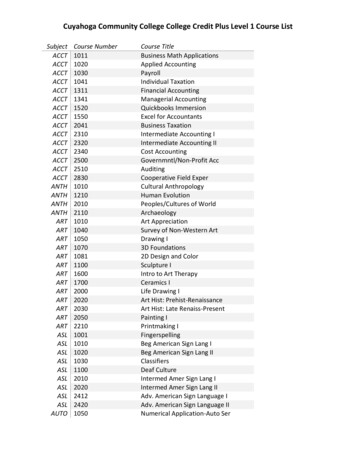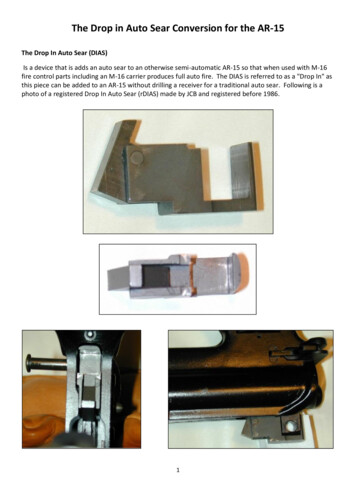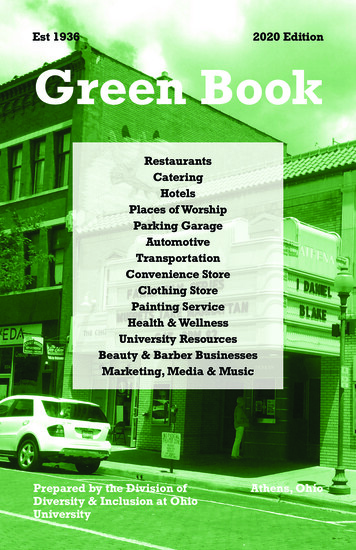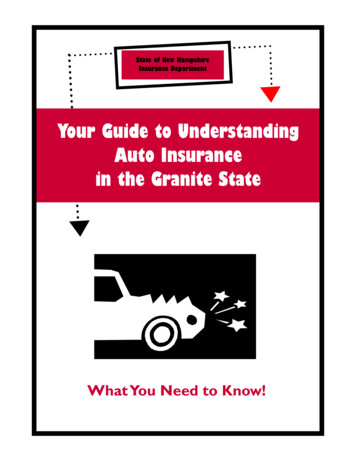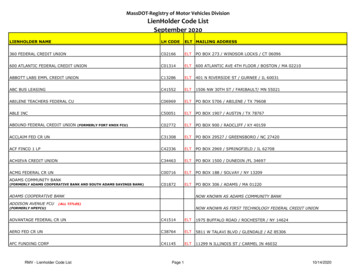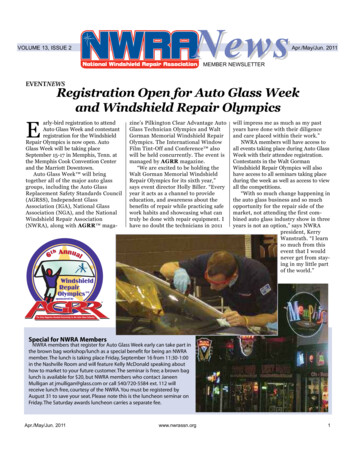
Transcription
Take control of yourauto loanA step-by-step guideConsumer FinancialProtection Bureau
How can this guide help you?While many people shop around for the best deal they can get on their vehicle, noteveryone shops for the best auto loan. This guide will help you focus on the totalcost of the loan, and not just the monthly payment. Preparing ahead of time andknowing how to navigate the process can help you save money, reduce stress, andget the auto loan that's right for you.This guide will walk you through:§§ Budgeting for your auto loan . . . . . . . . . . . . . . . . . . . . . . . . . . . .Section 1: Page 2§§ Understanding your auto financing choices. . . . . . . . . . . . . . . . .Section 2: Page 4§§ Shopping for your auto loan . . . . . . . . . . . . . . . . . . . . . . . . . . . . . .Section 3: Page 7§§ Negotiating your auto loan . . . . . . . . . . . . . . . . . . . . . . . . . . . . . . .Section 4: Page 13§§ Closing the deal. . . . . . . . . . . . . . . . . . . . . . . . . . . . . . . . . . . . . . . . .Section 5: Page 18How to use this guideThe location symbol orients you to where you are in the auto loan processThe magnifying glass highlights tips to help you research further and definesimportant termsThe auto loan worksheet at the end of this guide can help you compareloan choicesAbout the CFPBThe Consumer Financial Protection Bureau is a federal agency that helpsconsumer finance markets work by making rules more effective, by consistentlyand fairly enforcing those rules, and by empowering consumers to take morecontrol over their economic lives.
Budgeting for yourauto loanYou've decided it's time to purchase a newor used vehicle. Now it's time to figure outhow much you can afford.Make sure you have a realistic budget before shopping for anauto loan. If you have a realistic budget, you have a better chanceof ending up with a loan you can afford and pay on time. You willalso be more likely to account for ongoing costs, such as vehiclemaintenance and insurance.You will want to be sure that your budget will support both theloan and the other costs of ownership. If you are having troublecoming up with a budget that works for you, think about waysthat you can reduce the cost of your auto loan, such as:IN THIS SECTION1. Determine how muchloan you can afford2. Look beyond themonthly payment3. Factor in the costsof ownership4. Consider the resale valueof your new vehicle§§ Saving for a larger down payment§§ Buying a less expensive vehicle§§ Getting fewer features or options1. Determine how much loan you can you affordBefore you start the process of getting a loan, see how much you can afford. Makesure you have a realistic budget before shopping for an auto loan. The FederalTrade Commission's "Make a Budget" worksheet is a good place to get get-worksheet.pdf. For helpfulinformation on making a budget visit consumer.gov/articles/1002-making-budget.TAKE CONTROL OF YOUR AUTO LOANBUDGETING FOR YOUR AUTO LOAN2
While this consumer guide is focused on auto loans, you can also research whattype of vehicle fits into your budget. There are numerous publications andwebsites that discuss features and prices. Consumer Reports, Edmunds, KelleyBlue Book, and NADA Guides are just a few examples. These sources mayprovide information on prices for specific models and options. The Federal TradeCommission (FTC) also provides helpful information on buying and owning anautomobile at consumer.ftc.gov/topics/buying-owning-car.2. Look beyond the monthly paymentMany people think about a loan in terms of the monthly payment. Be careful here.The total cost of the vehicle financing matters. If you lower the monthly payment bytaking out a longer loan, you pay more in interest. A longer loan also puts you atrisk for negative equity over a longer period of time, which is when you owe moreon the vehicle than the vehicle is worth. To learn more about auto trade-ins andnegative equity check out the Federal Trade Commission's article d-negative-equity.3. Factor in all the costs of ownershipRemember to factor in the other costs of ownership, such as:§§ Additional costs at the time of purchase (state taxes, title fees, and dealer fees)§§ Ongoing costs throughout the time you own the vehicle (insurance, gas, annualregistration fees, maintenance, and repairs)4. Consider the resale value of your new vehicleAnother factor in your budgeting is the resale value of the vehicle that you areconsidering purchasing. A vehicle loses value over time. If you sell or trade in thisvehicle in the future, the value of the vehicle and whether you have paid off theloan before you want to sell it or trade it in will be an important factor in what youcan afford.TAKE CONTROL OF YOUR AUTO LOANBUDGETING FOR YOUR AUTO LOAN3
Understanding yourauto financing choicesYou've determined how much you canafford to spend. Now it's time to exploreyour loan choices.While some consumers are able to pay cash for their new vehicle,most consumers use financing. Understanding the loan processand knowing your choices will help you save money.IN THIS SECTION1. Know the sourcesof auto financing2. Understand howleasing worksFor example, bringing a loan quote from a bank, credit union, orother lender to the dealer can place you in a stronger bargainingposition to negotiate good financing terms with the dealer. Thenyou can choose whether you stick with the offer you brought in oraccept the dealer’s financing.1. Know the sources of auto financingYou can shop around for auto financing even before you shop for a vehicle. Banks,credit unions, and dealerships are the most common places to finance an auto loan.While shopping for auto loans is complicated, finding and comparing your choicescan help you improve the deal that you will get. Consider getting one or more loanquotes from a bank, credit union or other lender before going to the dealership. Itwill put you in a better bargaining position and could save you hundreds or eventhousands of dollars over the life of your loan.TAKE CONTROL OF YOUR AUTO LOANUNDERSTANDING YOUR AUTO FINANCING CHOICES4
Auto loans from a bank, credit union, or nonbank autofinance companiesYou can obtain a quote or preapproval on an auto loan from a bank, credit union,or other lender before selecting a vehicle. You can also check out nonbanklenders and online lenders as potential lenders. Although it might be helpful if youalready have an established relationship with a lender, you don’t have to have anaccount with these lenders in order to apply for an auto loan. These lenders can“preapprove” you. The preapproval will give you a loan quote with an interest rate,loan length, and maximum loan amount based on your creditworthiness, the termsof the loan, and the type of vehicle you have in mind. The rate and terms you areoffered may be negotiable.Dealer-arranged financingHere you obtain financing from a lender through a dealership. With dealerarranged financing, the dealer collects information from you and forwards thatinformation to one or more prospective auto lenders. If the lender(s) agrees tofinance your loan, they may authorize or quote a rate to the dealer to finance theloan, referred to as the buy rate.The interest rate that you negotiate with the dealer may be higher than the buyrate because it may include an amount that compensates the dealer for handlingthe financing. Dealers may have discretion to charge you more than the buy ratethey receive from a lender, so you may be able to negotiate the interest rate thedealer quotes to you. Ask or negotiate for a loan with better terms. After the autopurchase is finalized, a dealer-arranged loan may then be sold to a lender who hasalready indicated a willingness to extend the credit. That lender may own your loanand collect the monthly payments, or transfer those responsibilities and rights toother companies. Learn more about buy rate at consumerfinance.gov/askcfpb/727."Buy Here Pay Here" dealership financingSome types of dealerships finance auto loans “in-house” to borrowers with nocredit or poor credit. At “Buy Here Pay Here” dealerships, you might see signswith messages like “No Credit, No Problem!” The interest rate on loans from thesedealerships can be higher than loans from a bank, credit union, or other type oflender. You may want to consider whether the cost of the loan outweighs the benefitof buying the vehicle. Even if you have poor or no credit, it may be worth it to see ifthere is a bank, credit union, other lender, or another dealer that is willing to makea loan to you. A feature of this type of dealership is that your monthly payment ismade to the dealership. Some “Buy Here Pay Here” dealerships, and some otherTAKE CONTROL OF YOUR AUTO LOANUNDERSTANDING YOUR AUTO FINANCING CHOICES5
lenders that lend to people with no credit or poor credit, may put devices in thevehicle that help them repossess or disable the vehicle if you miss a payment.Negotiate interest ratesIn general, lenders and dealers are not required to offer the best interestrates available. You may be able to save a lot of money over the life of theloan by negotiating the interest rate with the lender or dealer.2. Understand how leasing worksLeasing is an alternative that some people choose. A lease is an agreement topay to use a vehicle for an agreed number of months and/or miles. If you lease avehicle, you do not own it and you will be required to return the vehicle after thelease ends, unless your contract includes a purchase option and you choose to payto exercise that option.If you are considering leasing, carefully compare the costs of leasing and buying.Complete information about leasing a vehicle is outside the scope of this consumerguide on auto loans. Learn more about leasing at consumerfinance.gov/askcfpbor check out the Federal Reserve's consumer guide, "Keys to Vehicle Leasing," atfederalreserve.gov/pubs/leasing.TAKE CONTROL OF YOUR AUTO LOANUNDERSTANDING YOUR AUTO FINANCING CHOICES6
Shopping for yourauto loanYou know your loan options. Now it's timeto shop for your auto loan.Shopping for loans and trying to get the best rates and otherterms, while complicated, is like other types of comparisonshopping. Shopping ahead of time will get you ready fornegotiating your auto loan and make the process less stressful.1.IN THIS SECTION1. Prepare before youapply for an auto loan2. Shop for your auto loanPrepare before you apply for an auto loanYou will be in a better position to shop and bargain for an autoloan if you follow these steps before you apply for a loan.Check your credit reportThe information in your credit report determines your credit scores. Your creditscore plays a large part in determining what kind of auto loan you can get, andhow much interest you will pay for the loan. Here are some helpful resources:§§ To get a free copy of your credit report annually from each of the threenationwide credit reporting agencies visit annualcreditreport.com§§ To learn how to check your credit report for errors and dispute any errors thatyou find visit consumerfinance.gov/askcfpb/314§§ To learn about credit reports and credit scores, visit consumerfinance.gov/askcfpb/search/?selected facets category exact:credit-reportingTAKE CONTROL OF YOUR AUTO LOANSHOPPING FOR YOUR AUTO LOAN7
Do you need a co-signer?A co-signer is a person – such as a parent, family member, or friend – whois contractually obligated to pay back the loan just as you are. If yourcredit history is limited or needs improvement, and you have a low creditscore (or no credit score), your interest rate could be significantly lowerif you have a co-signer with good or excellent credit. That is because thelender will rely on the co-signer’s credit history and score in deciding tomake the loan.If you are considering having a co-signer, you and the potential co-signershould think carefully about this decision. If you do not repay your loan,you and your co-signer will be responsible for repayment. The co-signer isresponsible for the loan even though he or she has no right to possessionof the vehicle. In addition, any late payments made on the loan wouldaffect both your credit record and score and your co-signer’s creditrecord and score. Federal law generally prohibits a lender from requiringyou to have a co-signer if you apply for a loan individually and you qualifyunder the lender’s standards for creditworthiness for the loan. For moreinformation on co-signing visit consumerfinance.gov/askcfpb/811.Check current auto loan interest ratesYou can research rates by contacting several banks, credit unions, or other lenders.You can also look online at many commercial sites which may give you an estimateof interest rates nationwide and by your zip code. Some commercial sites will linkyou to specific lenders and dealers for estimates, so you may want to be carefulabout entering your personal information.Consider a down paymentA down payment will reduce the total amount that you finance because you willhave to borrow less money. The larger the down payment, the lower the total costof the loan.Decide if you want to trade in your current vehicleIf you already own a vehicle, research its value to see how much you might getfrom a trade-in or private sale. You can look up the approximate value using onlinecommercial websites such as Consumer Reports, Edmunds, Kelley Blue Book,TAKE CONTROL OF YOUR AUTO LOANSHOPPING FOR YOUR AUTO LOAN8
NADA Guides, and online classifieds. These resources may also be available atyour local library. Finding examples of similar vehicles that have sold recently inyour area will help you know a fair price.Once you know approximately how much your current vehicle is worth, you candecide whether to trade it in or sell it yourself. If you trade it in at a dealership, youand the dealer will decide on the value that will be credited towards the purchaseprice of your next vehicle. If you sell it yourself, you can use the money you get as adown payment.If you have an existing auto loan on your trade-in, consider yoursituation carefullyCarefully consider whether to take on new debt in addition to your existing debt.Here are some considerations and steps:§§ Get the payoff amount, which is the amount to pay off the existing loan, fromyour current lender before going to the dealership.§§ Decide if you are going to pay off your existing loan now, wait until you pay offyour old auto loan before you borrow for another vehicle, or include the amountthat you still owe on your current vehicle in your new auto loan.§§ If you owe more on your current vehicle than it is worth — referred to as beingupside down — then you have negative equity. If you roll the balance of yourexisting auto loan into your new auto loan, this could make the new auto loanmuch more expensive. Your total loan cost will be higher because you will beborrowing more than just the price of your new vehicle.§§ After you research your trade-in’s value, if the amount you still owe on yourtrade-in is less than it is worth, make sure during any negotiations that youconsider whether you are getting fair value for your trade-in and you are able tofully pay off the old auto loan.TAKE CONTROL OF YOUR AUTO LOANSHOPPING FOR YOUR AUTO LOAN9
Do you still owe money on your trade-in?If you are considering rolling the balance of the old loan into your newloan, make sure you understand how this will affect the total cost of yournew loan. Carefully look at the total cost of the new loan including theamount borrowed, the annual percentage rate (APR), the interest rate, theloan term (in months), and the monthly payment – before you agree toanything. If you don’t roll the amount you still owe on your old vehicle intothe new loan, and keep your current vehicle while buying a new one, thenyou will have two loans and two monthly payments to make. Either way,you may want to consider whether it makes sense to go through with thetransaction and purchase the next vehicle if you still owe money on yourtrade-in. For more information visit consumerfinance.gov/askcfpb/779.Think about optional add-ons ahead of timeWhen you go to an auto dealer, you will likely be offered add-on products andservices for the vehicle or for the loan. It’s a good idea to think about these add-onsahead of time, so that you have less to worry about at the dealership, and have youranswers ready when you are asked to buy these extras. Common add-ons include:§§ Service contracts or extended warranties(consumerfinance.gov/askcfpb/825)§§ Guaranteed Auto Protection (GAP) insurance(consumerfinance.gov/askcfpb/797)§§ Credit insurance(consumerfinance.gov/askcfpb/799)§§ Additional features for the vehicle, such as alarm systems, window tinting, tireand wheel protection, and other productsThese products and services, which you may finance, are optional. If you buy themthe price is negotiable. If you think you want to buy these products or services,shop around. For example, your own auto insurance company may offer GAPinsurance, credit insurance, or other alternatives. If you finance optional add-ons aspart of your loan, the amount you borrow and pay will increase.Now that you’ve done your homework, you’re ready to take the next step:shopping for your auto loan. Use the auto loan worksheet at the end of this guideTAKE CONTROL OF YOUR AUTO LOANSHOPPING FOR YOUR AUTO LOAN10
to keep track of the loan terms and compare your choices. Take the worksheet withyou to the bank, credit union, other lender, and dealership so you can compareyour loan choices and get the best deal for you.2. Shop for an auto loanNow you are ready to start shopping for a loan. Before you head to the dealership,gather your personal information and consider getting preapproved for a loan.Shopping ahead of time will get you ready for negotiating your auto loan and makethe process less stressful.Gather your personal informationWhen you’re heading over to a bank, credit union, or dealership make sureto gather all the information you will need. Lenders will generally ask for thisinformation in a loan application:§§ Name§§ Social Security Number or ITIN§§ Date of birth§§ Current and previous address(es) and length of stay§§ Current and previous employer(s) and length of employment§§ Occupation§§ Sources of income§§ Total gross monthly income§§ Financial information on current credit accounts, including other debtsGet preapproved for a loanGetting a preapproved loan offer or quote with a maximum loan amount and ratefrom a bank, credit union, or other lender is a good place to start. If you bringa loan quote from a lender to the dealer, you may be in a stronger bargainingposition to get a better deal, whether you stick with the offer you brought in or youdecide to accept the dealer’s financing offer.Preapproval also helps you stay within your budget and allows you to compareinterest rates without the time pressure you may feel once you are at theTAKE CONTROL OF YOUR AUTO LOANSHOPPING FOR YOUR AUTO LOAN11
dealership. Then at the dealership you can focus more on the actual price of thevehicle and your trade-in because you will already know about the loan termsthat you could get. You will still have the choice to negotiate a better loan at thedealership and not use your preapproval.If your application is preapproved, the lender will give you documents to take tothe dealership. Once you are ready to buy, the dealer will make final arrangementswith your lender.Understand how shopping for a loan impacts your credit scoreShopping for the best deal on an auto loan will generally have little to no impacton your credit score(s). The benefit of shopping will far outweigh any impact on yourcredit. In some cases, applying for multiple loans over a long period of time canlower your credit score(s). Depending on the credit scoring model used, generallyany requests or inquiries by these lenders for your credit score(s) that took placewithin a time span ranging from 14 days to 45 days will only count as a single inquiry.This means shopping around for an auto loan during that time span will count thesame as applying for just one loan. You can minimize any negative impact on yourcredit score by doing all your rate shopping in a short amount of time.Know your rightsA lender cannot discourage or deny your application for credit, or offer differentprices or other terms and conditions of the loan, based on your race, color, religion,national origin, sex, marital status, age, receipt of public assistance income, orgood faith exercise of any right under the Consumer Credit Protection Act.You can submit a complaint online with the Federal Trade Commission (FTC) atftccomplaintassistant.gov or with the Consumer Financial Protection Bureau(CFPB) at consumerfinance.gov/complaint or by calling toll-free at 1-855-411-CFPB(2372). You can also tell us about your experience without submitting a formalcomplaint.TAKE CONTROL OF YOUR AUTO LOANSHOPPING FOR YOUR AUTO LOAN12
Negotiating yourauto loanYou've shopped for your auto loan. Nowit's time to negotiate your loan terms.When you look for a vehicle, you may know that you cannegotiate the vehicle’s price, but did you know that you canalso shop around for and negotiate the terms of your auto loan?Shopping for loans and trying to get the best rates and terms,while complicated, is like other types of comparison shopping.Shopping and negotiating can save you hundreds or eventhousands of dollars over the life of your loan.1.IN THIS SECTION1. Know what is negotiable2. Negotiate to lower thecost, not just the monthlypayment3. Keep track of multiplefactors while negotiatingKnow what is negotiableWhile you may know that you can negotiate over the price of the vehicle and theinterest rate, it’s also important to know all the factors that you can negotiate overthat may impact the cost of your auto loan. You should consider all these factorswhen you buy and finance a vehicle. In addition to the price of the vehicle, here aresome other terms or costs that you can negotiate:§§ Trade-in value (if you trade in your vehicle) and down payment amount§§ Annual Percentage Rate (APR) and interest rate§§ Length of loan§§ Whether or not there will be a prepayment penaltyTAKE CONTROL OF YOUR AUTO LOANNEGOTIATING YOUR AUTO LOAN13
§§ Price of optional features and services for the vehicle or the loan such asextended warranties, credit life insurance, GAP insurance, alarm systems, tireand wheel protection, window tinting, and other products§§ Fees charged by the dealer such as dealer preparation fees, delivery charges,and document feesYou cannot negotiate taxes, vehicle title, and registration fees. These fees are setby your local or state government.Be cautious of some biweekly payment plansIt is possible to be offered an auto loan with biweekly (every 2 weeks)payments instead of monthly payments. This may make the loan look moreaffordable than it really is because of the smaller payment. There also maybe additional fees charged for enrolling in a biweekly payment plan.If your loan has biweekly payments, there will be some months whenyou will have three payments instead of two. This is because there are 26biweekly payment periods every year, the same as if you were making 13monthly payments instead of 12. Make sure that you know whether yourloan payments are monthly or biweekly, and factor the extra biweeklypayments into your budgeting if you make this choice.2. Negotiate to lower the total cost, not just themonthly paymentWhen you are looking for a loan, you may find it easy to focus just on the monthlypayment or the price of the vehicle. But looking at just one factor doesn’t give youthe whole picture. A lower payment doesn’t necessarily mean a lower interest rate;it might just mean that you are paying for a longer time. The best way to compareauto loans is by using the total cost of the loan. Use the auto loan worksheet at theend of this guide to help you calculate and compare the total cost.Your total loan cost starts with the amount financed. The amount financed is theamount of money you are borrowing. It includes the price of the vehicle, taxes andother government fees, as well as any optional add-ons like extended warrantiesand optional credit insurance, minus your down payment and any trade-in amount.The amount financed does not include the cost to borrow the money. That cost isTAKE CONTROL OF YOUR AUTO LOANNEGOTIATING YOUR AUTO LOAN14
known as the finance charge and includes interest and certain fees over the lifeof the loan. Your total loan cost is the amount financed plus the finance charge.By negotiating for better terms on your loan, you can reduce the total amount ofmoney you pay over time. For example:§§ Getting a lower interest rate means you will pay less to borrow money. The totalcost of your loan will be lower.§§ A shorter loan term (in which you make monthly payments for fewer months) willlower your total loan cost. A longer loan can reduce your monthly payment, butyou pay more interest over the life of the loan.§§ A higher down payment, or a higher price for your trade-in, will reduce the totalamount financed because you will have to borrow less money.§§ Optional add-on products like extended warranties, GAP insurance or creditinsurance that are added into your loan amount will increase your total costbecause you will be borrowing more money.How the length of your loan term affects what you payBelow is a sample comparison to illustrate how you will pay less in the long runif you have a shorter loan term. The table below assumes a 20,000 loan and aninterest rate of 4.75%.Loan termMonthly paymentTotal interest paid36 months 597 1,49848 months 458 1,99960 months 375 2,50872 months 320 3,024(3 years)(4 years)(5 years)(6 years)TAKE CONTROL OF YOUR AUTO LOANNEGOTIATING YOUR AUTO LOAN15
While the lower monthly payment for a longer period of time may look like theway to go, consider the total interest cost over the term of the loan. If you paidoff a 20,000 loan in 3 years, you will pay 1,498 in interest. For a 6 year loan, youwill pay 3,024 in interest--more than twice as much. Some financial advisersrecommend keeping the length of your auto loan to 5 years or less, reasoning thatthe longer the loan, the more likely you will owe more than the vehicle is worth.On the auto loan worksheet enter the amounts on several loans you arecomparing to see your estimated monthly payments, total interest cost, and thetotal cost that you will pay over the life of the loan. For additional help, thereare a number of auto loan calculators available online. For example, ConsumerReports (consumerreports.org/static/0 percent.html) and the NADA Guides(nadaguides.com/Cars/Payment-Calculator) provide online auto loan calculatorsthat may be helpful in evaluating and comparing the costs and terms of variousauto loans.3. Keep track of multiple factors while negotiatingWhen you are negotiating for financing with a lender or at a dealership, make sureyou are keeping track of all the factors that go into the total cost of the loan. If youare negotiating the interest rate, make sure that you also know the length of theloan and other terms. Comparing total loan cost will help you keep an eye onthese multiple factors. Use the auto loan worksheet to help keep track of thedifferent factors.Ask the dealer to tell you the price, trade-in amount, interest rate, term of loan,estimated monthly payments, and write these numbers down on the auto loanworksheet. It’s best to get these numbers early in the process, so you can bettercompare and negotiate.Just as the first price you are offered for the vehicle may not be the lowest priceavailable to you, the first rate for a loan the lender or dealer offers you may notbe the lowest rate you qualify for. If the lender or dealer agrees to a better loanfeature (such as a lower APR or interest rate), check to make sure that the otherfactors like the length of the loan or the amount financed haven’t changed. A lowermonthly payment doesn’t necessarily mean a lower interest rate; it might just meanthat you are paying for a longer time.After you’ve agreed on the price of the vehicle, here are some additional tips tohelp you negotiate the best loan:TAKE CONTROL OF YOUR AUTO LOANNEGOTIATING YOUR AUTO LOAN16
§§ Know what your trade-in is worth and bargain over the amount you will get foryour trade-in. This will reduce the amount you borrow.§§ Negotiate over the interest rate for your loan, comparing interest rates obtainedfrom your bank, credit union, or other lender with the rate you are offered bythe dealer.§§ If the dealer is arranging your financing, make sure you understand how theinterest rate was determined and ask if your credit score qualifies you for a loanwith better terms.Strengthening your position at the bargaining tableYou are not required to get a loan from a dealer or trade in a vehicle inorder to purchase a car from a dealer. A bank, credit union, or other lendermay offer you better loan terms than the dealer. Bringing a loan quote orpreapproval from another lender to the dealer can place you in a strongerbargaining position to negotiate good financing terms with the dealer. Thenyou can decide which loan to accept.TAKE CONTROL OF YOUR AUTO LOANNEGOTIATING YOUR AUTO LOAN17
Closing the dealYou’ve now negotiated your auto loan.Before you drive away, make sureeverything matches what you agreed to.You are almost finished! The hard part is done and now comes animportant final step. You have to review the paperwork, check thefinal terms and numbers against the auto loan worksheet, and befully satisfied that the written deal is what you want.IN THIS SECTION1. Verify that you get whatyou agreed to2. Check the p
negotiating your auto loan and make the process less stressful. 1. Prepare before you apply for an auto loan You will be in a better position to shop and bargain for an auto loan if you follow these steps before you apply for a loan. Check your credit report The information in your credit report determines your credit scores. Your credit
